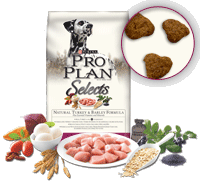|
|
|
Reviews
|
Views
|
Date of last review
|
|
1
|
53628
|
Wed January 2, 2008
|
|
|
Recommended By
|
Average Price
|
Average Rating
|
|
No recommendations
|
None indicated
|
None indicated
|
|
|
|

|
|
Description:
|
Feeding guideline:
A 50lb dog should be fed about 2 1/4 cups
CALORIE CONTENT (CALCULATED):
Metabolizable Energy (ME):
4157 kcal/kg
466 kcal/cup
1890 kcal/lb
INGREDIENTS:
Turkey, brewers rice, pearled barley, chicken meal (natural source of glucosamine), corn gluten meal, oat meal, animal fat preserved with mixed-tocopherols (form of Vitamin E), dried egg product, fish meal (natural source of glucosamine), pea fiber, dried beet pulp, fish oil, natural flavor, calcium phosphate, potassium chloride, salt, L-Lysine monohydrochloride, calcium carbonate, dried tomatoes, blueberry pomace, dried sweet potatoes, Vitamin E supplement, zinc proteinate, manganese proteinate, choline chloride, ferrous sulfate, L-ascorbyl-2-polyphosphate (source of Vitamin C), niacin, copper proteinate, Vitamin A supplement, calcium pantothenate, thiamine mononitrate, riboflavin supplement, Vitamin B-12 supplement, pyridoxine hydrochloride, garlic oil, folic acid, Vitamin D-3 supplement, calcium iodate, biotin, menadione sodium bisulfite complex (source of Vitamin K activity), sodium selenite.
GUARANTEED ANALYSIS:
Crude Protein (Min) 27.0%
Crude Fat (Min) 17.0%
Crude Fiber (Max) 4.0%
Moisture (Max) 12.0%
Linoleic Acid (Min) 1.4%
Calcium (Ca) (Min) 1.0%
Phosphorus (P) (Min) 0.9%
Vitamin A (Min) 15,000 IU/kg
Vitamin E (Min) 460 IU/kg
Ascorbic Acid* (Min) 70 mg/kg
Docosahexaenoic Acid (DHA)* (Min) 0.15%
Eicosapentaenoic Acid (EPA)* (Min) 0.15%
Glucosamine* (Min) 600 ppm
Glutamine* (Min) 1.0%
Omega-3 Fatty Acids* (Min) 0.4%
Omega-6 Fatty Acids* (Min) 2.0%
*Not recognized as an essential nutrient by the AAFCO Dog Food Nutrient Profiles.
|
|
|
|
Editors
Registered: October 2005
Posts: 3953
|
|
Review Date: Wed January 2, 2008
|
Would you recommend the product? No |
Price you paid?: Not Indicated
| Rating: 0
|
|
Pros:
|
First and third ingredients are named meat products
|
|
Cons:
|
Inadequate meat content, mixed quality grains, fat of unidentifiable origin, controversial filler
|
|
The first ingredient is a named meat product, but this is not a meal ingredient, meaning that it is inclusive of water content (about 80%). Once that is removed, as it must be to create a dehydrated product, the ingredient will weigh around 20% of its wet weight. Ingredients are listed in order of weight, and the dehydrated ingredient would probably be more accurately placed much further down the ingredient list. The first true meat ingredient does not occur until 4th on the ingredient list, makin git extremely unlikely that this product contains any meaningful amount of meat. There is a further meat meal ingredient is 9th on the ingredient list, but this is too far down to make a substantial contribution to the meat content of this food. This is a fish meal ingredient, but We find no guarantee on the manufacturers website that protein sources are ethoxyquin-free (ethoxyquin is a chemical preservative commonly added to fish destined for meal, and is believed to be carcinogenic).
The first grain, and the main ingredient, in the food is brewers rice. This is a low quality ingredient and byproduct. Barley is a decent quality grain, but corn is a difficult to digest grain that is commonly associated with food allergy problems in dogs. Corn Gluten Meal is the dried residue from corn after the removal of the larger part of the starch and germ, and the separation of the bran by the process employed in the wet milling manufacture of corn starch or syrup, or by enzymatic treatment of the endosperm. In plain English, that bit of the corn leftover after most of the nutritious bits have been removed.
Animal fat is an ingredient of unidentified origin for which it is impossible to determine species, source or quality. Unidentified ingredients are usually very low quality. AAFCO define this asobtained from the tissues of mammals and/or poultry in the commercial processes of rendering or extracting. It consists predominantly of glyceride esters of fatty acids and contains no additions of free fatty acids. If an antioxidant is used, the common name or names must be indicated, followed by the words "used as a preservative". We would prefer to see the use of whole eggs rather than egg product in the food.
Beet pulp is controversial filler which appears to be used in large quantities in this food. It is a by-product, being dried residue from sugar beets which has been cleaned and extracted in the process of manufacturing sugar. It is a controversial ingredient in dog food, claimed by some manufacturers to be a good source of fibre, and derided by others as an ingredient added to slow down the transition of rancid animal fats and causing stress to kidney and liver in the process. We note that beet pulp is an ingredient that commonly causes problems for dogs, including allergies and ear infections, and prefer not to see it used in dog food. There are less controversial products around if additional fibre is required.
There is a small range of fruit/vegetable matter in the food. We note that this product includes synthetic vitamin K, a substance linked to liver problems and that is progressively being removed from better quality dog food products.
|
|
|
Powered by: ReviewPost PHP
Copyright 2006 All Enthusiast, Inc.
|
|